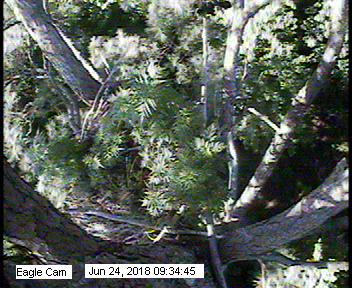Platteville, CO

Eagles
| Massachusetts NE Energy Power Generation |
|
 |
Eagle Cam is a cooperative effort among NE Energy, MassWildlife and the United States Fish and Wildlife Service (USFWS). A photovoltaic array powers the remote camera and transmits the signal from the island to a nearby receiver. MassWildlife provides climbers to maintain the system, places buoys and signs to protect each nesting attempt and, when appropriate, bands young eagles produced at the nest. The USFWS, through the Silvio Conte National Fish and Wildlife Refuge office in Montague, Massachusetts, coordinated the installation of the Eagle Cam system and serves as the local contact to keep both the system and the partnership up and running. Images provided by Eagle Cam are directed by the USFWS to local cable access television and to the Internet. |
| Maine National Wildlife Federation |
|
 |
This bald eagle pair has successfully raised chicks in this nest for ten years, where they have raised 16-17 chicks. Many bald eagle pairs only tend to their nests just before laying their eggs, but this pair is very dedicated to their nest year round. They are very territorial and chase away any juvenile eagles who try to visit the nest. It's possible that some of those young eagles are their own chicks but there is no way to know that, and the parents do not recognize their chicks once they have left the nest. The pair spends a lot of time bringing materials to the nest, which is now about six feet across and 15 feet in height. That is one huge nest! The nest sits in the crook of a massive white pine tree and weighs a LOT. It's interesting to think how they got the first sticks to balance when building their nest. The nest is about 30 feet in the air almost near the top of the tree but with lots of branches around to provide protection. The nest is close to the Atlantic Ocean in Maine, so the eagles eat food from nearby ocean and freshwater environments. Generally bald eagles are scavengers which eat from already dead animals or fish, so this pair would get a lot of food from the ocean shoreline (the intertidal zone). As we got closer to the eggs being laid in February 2006, the pair spent more time each day in and near the nest. They did "practice incubation" where they would sit in the nest for 45 minutes to three hours. They would bring sticks to strengthen the nest. They increasingly brought their food to the nest to eat rather than eating it where they found it. These eggs were laid on March 6. Bald eagles normally incubate their eggs for about 35 days, so we would expect the chicks to appear about April 10. However we could not see if this happened because the chicks are down inside the nest. |
| Blackwater Refuge - Cambridge, MD Blackwater Refuge |
|
 |